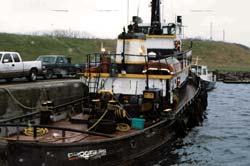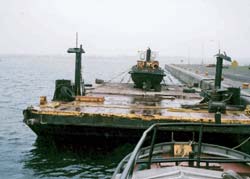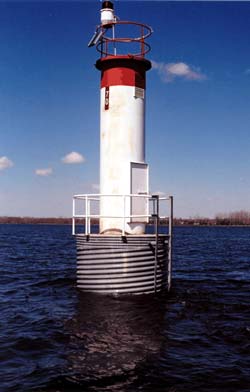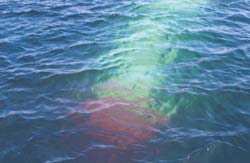Striking
of Crib Light 82
by the tug-barge unit Progress/Pitts Carillon
in the Saint Lawrence Seaway
off Broder Island, Ontario
The Transportation Safety Board of Canada (TSB) investigated this occurrence for the purpose of advancing transportation safety. It is not the function of the Board to assign fault or determine civil or criminal liability. This report is not created for use in the context of legal, disciplinary or other proceedings. See Ownership and use of content. Masculine pronouns and position titles may be used to signify all genders to comply with the Canadian Transportation Accident Investigation and Safety Board Act (S.C. 1989, c. 3).
Summary
In the late evening of 21 April 2002, while proceeding upbound in the Saint Lawrence Seaway off Broder Island in calm conditions, the barge Pitts Carillon, pushed by the tug Progress, struck and knocked over crib light 82. As the tug and barge continued to sail over the submerged navigation aid, both vessels were holed and took on water. They were able to proceed to an Iroquois Lock service dock for inspection and repairs. There was no pollution and no one was injured.
Factual information
Particulars of the vessels
| Name | "PROGRESS" | "PITTS CARILLLON" |
|---|---|---|
| Official number | 179211 | 311514 |
| Port of registry | Nanticoke, Ontario | Montréal, Quebec |
| Flag | Canada | Canada |
| Type | Tug | Barge |
| Gross tonnage | 123 | 260 |
| LengthFootnote 1 | 24.5 m | 28 m |
| Draught | Forward: 1.5 m Aft: 3.0 m | Forward: 1.5 m Aft: 1.5 m |
| Built | 1948, Owen Sound, Ontario | 1959, Waubaushene, Ontario |
| Propulsion | Two 1671 Detroit diesel engines with twin screw; 1491.4 kW | None |
| Cargo | None | Work boat |
| Crew | 6 | None |
| Owners | McKeil Marine Ltd. | Galcon Marine Ltd. |
Description of the tug-barge unit
The Progress is a conventional harbour tug of steel construction. The navigation bridge is above a tier of superstructure on the fore part of the main deck. There is one conning position in the wheelhouse, which has an open layout with wide windows giving an unobstructed view in all directions from approximately 6 m above the waterline.
On the main deck, just aft of the superstructure, is a towing winch and a set of towing bollards for the purpose of pulling on a towline over the tug's stern (see Photo 1). The tug was not designed for push-towing operations and was not fitted with a push-towing arrangement.
The Pitts Carillon is a flat-topped steel barge designed to carry deck cargo. It is fitted with two anchoring spuds, which were in the raised position for transiting the Seaway. A 10 m long work boat was secured aft on the deck at centre. The spuds and work boat projected approximately 3.5 m above the barge's deck (about 5.5 m above the waterline). (See Photo 2.)
Description of the navigation aid
Crib light 82 is located approximately 100 m southeast of Broder Island. The fixed navigation aid is a white circular tower with a red top 10.1 m high above water level, resting on a 3.5 m diameter concrete base. The light characteristic is flashing red with a four-second interval and it has a nominal range of 4 nautical miles (see Photo 3).
History of the voyage
At 2105,Footnote 2 on 20 April 2002, the tug Progress, pushing the barge Pitts Carillon, departed Montréal bound for Hamilton, Ontario. The tug's bow had been made fast to the bow (raked end) of the barge, thereby making the square-ended stern of the barge the leading edge of the tow (see Figure 1). En route, the master observed that the tug-barge unit proceeded at an unusually slow speed of only 4 knots at full ahead power.
After exiting the Saint-Lambert lock, the Seaway Beauharnois Traffic Control Station was informed that the unit would be secured in the vicinity of Côte-Sainte-Catherine for crew rest. Under directions from the master, the first officer would conduct the vessel through the South Shore Canal to the next lock and, if necessary, to extend his watch accordingly.
At 0130 on 21 April 2002, the tug-barge unit tied-up at the Côte-Sainte-Catherine approach wall. The crew rested until about 0500, and at 0530, they undertook to disconnect the tow and reposition the tug to make its bow fast to the stern of the barge (see Figure 2). Upon completion of the tug-barge connecting rigging, concern was expressed that the rig was inadequately secured and that additional spring lines were necessary to safely operate the tow. The master did not deem it necessary to rig additional spring lines. However, when the unit stopped later, during the Seaway transit, extra spring lines were utilized.
At approximately 0630, the tug-barge unit got underway with the barge's raked bow heading the tow. The full ahead speed of the unit then increased to 7 knots. At this stage, a decision was made to work a rotating shift of three hours of work and three hours of rest, and this decision was conveyed to the first officer. The first officer stood the first watch. The master visited the bridge for brief periods during the first officer's watches.
At 1850, the master had taken the tug and tow unit through the Snell Lock and the first officer started his next watch. The master retired to his cabin at 2000.
At 2200, the master visited the bridge; there was no shipping traffic in the vicinity. At this time it was suggested that the officers would revert to a "six on–six off" schedule at midnight. The first officer, although having expressed that he was exhausted, agreed.
At 2225, the watchman went down to the galley to prepare a sandwich for the first officer. As the tug was not equipped with an autopilot (nor was one required by regulations), the first officer had to steer the vessel while performing other navigational duties.
At approximately 2230, the captain was in his cabin and the tow was approaching Broder Island when two successive crashing sounds were heard as the tug jolted abruptly to port. The tug-barge unit had knocked down crib light 82 and continued to sail over the submerged navigation aid. (See Appendix A – Sketch of the occurrence area.)
The occurrence was reported immediately to Seaway Iroquois Traffic Control Station and to the vessel owners. Both the tug and the barge were holed and took on water. However, the crew was able to control the ingress of water using available pumps. The tug-barge unit proceeded upstream to a Seaway service dock at Iroquois Lock for subsequent survey and repairs.
Damage to the tug and barge
The Progress was holed below the waterline in two locations approximately 2 m abaft the collision bulkhead. The forward starboard corner of the barge Pitts Carillon was indented and water entered through a side shell fracture. Both vessels sustained damage to shell plating and associated framing.
Damage to the navigation aid
Crib light 82 was knocked from its concrete base and remained submerged (see Photo 4).
Weather conditions
At 2200 on April 21, the Environment Canada Marine Weather Broadcast for the greater Morrisburg to Iroquois section of the St. Lawrence River reported calm and clear conditions with good visibility. The river current was 1.5 to 2 knots.
Personnel certification and experience
The master had acquired command experience on a small passenger ferry in Sorel, Quebec, and on fishing vessels off the Gaspé peninsula. The master held a Certificate of Competency for "Master, Ship of Not More Than 350 Tons, Gross Tonnage, or Tug, Local Voyage" since September 2001, and had been operating a commercial tug for the present owners.
The first officer had been at sea for some 30 years and acquired experience as a navigation officer aboard tankers and other types of vessels. He held a Master Intermediate Voyage certificate of competency. He had gained some experience assisting in piloting on the Great Lakes, some four years earlier. In 2001, he was hired by the present owners as a navigation officer to perform a single 30-day ocean-going delivery voyage of a vessel. His assignment as first officer on the tug Progress was to be over after completing the push-tow of the Pitts Carillon .from Montréal to Hamilton
The watchman on duty with the first officer was a deckhand with no steering experience, and his duties on the bridge were mainly as a lookout and to identify conspicuous navigation marks. The regulations do not require steering experience for a deckhand who is acting as watchman. His usual duties included the handling of mooring lines during (un)docking, locking duties, and securing deck cargo and towlines.
Hours of work and rest practices
The master and first officer joined the Progress on 07 April 2002. When on duty, they worked for six hours followed by six hours of rest. They were required to keep cargo and sea watches while making round-trip voyages. During the shift work, the master and the first officer relieved each other as required. In the evening, prior to the occurrence, it was reported that some of the crew members were not getting sufficient rest because they had to perform lock duty, or that they could not sleep in their off-watch period.
Crewing Regulations pursuant to the Canada Shipping Act, Division 2, state the following :
- 13. (1) The Master of a ship … shall ensure that the complement on board is … organized efficiently in a watchkeeping system and work system…
- 13. (2) The Master of a ship … and each member of the complement have
- a period of rest of not less than six consecutive hours in every 24-hour period; and
- at least 16 hours of rest in every 48-hour period.
In the 24 hours preceding the accident, the longest period of uninterrupted rest for the crew occurred between 0130 and 0500 on 21 April 2002. Following that rest period, the navigation personnel worked for three hours followed by three hours of rest until approximately 2230, the time of the accident. Additionally, the crew had consumed varying amounts of caffeine beverages to stay awake, and during their off periods, they were unable to obtain sleep.
Navigation practices
The master and the first officer shared the navigation of the tug-barge unit. The master would berth-unberth the tug-barge unit, and most crew members would stand watch during lock transits. The master would then retire to his cabin, one flight of stairs below the wheelhouse, while the first officer was in charge of the navigation. During the master's watch, he was assisted by a crew member who was an experienced helmsman.
Navigation of the tug, which included pilotage and helmsman duties, was difficult for the first officer, as the Progress was not equipped with an autopilot and his lookout had no steering experience. Consequently, in order to carry out navigation duties while steering, he had to steady the unit on course, then briefly leave the helm unattended to perform another function, before the tug-barge unit deviated too far from the chosen course.
On the night of the striking, the last entry in the logbook during passage was made by the first officer at 2115, when passing calling-in-point No. 11 en route from Eisenhower Lock to Iroquois Lock. No record was found which would assist in reconstructing the track of the tug-barge unit before reaching Broder Island.
Analysis
The first officer was unaware of the vessel's relative position to crib light 82. This analysis will focus on those elements that contributed to the first officer's ability to effectively navigate the vessel, including the composition of the watch and the effects of the crew's schedule on performance.
Watch composition
According to Section 38 of the Crewing Regulations, Requirements for Deck Watches,Footnote 3 and the Code of Nautical Procedures and Practices (TP 1018), the composition of the watch shall at all times be adequate and appropriate to the prevailing circumstances and conditions, and shall take into account the need for maintaining a proper lookout. TP 1018 also mentions various factors that must be taken into account when deciding the composition of the watch on the bridge:
- at no time shall the bridge be left unattended;
- weather conditions, visibility and whether there is daylight or darkness;
- proximity of navigational hazards which may make it necessary for the officer in charge of the watch to carry out additional navigational duties;
- use and operational condition of navigational aids such as radar or electronic position-indicating devices and any other equipment affecting the safe navigation of the ship;
- whether the ship is fitted with automatic steering;
- any unusual demands on the navigational watch that may arise as a result of special operational circumstances.
Given that the vessel was operating in restricted waters, a helmsman should have been assigned to steer the vessel. When the first officer was on navigation duty during the course of the voyage, a deckhand was assigned to assist him on the bridge. Having had no experience in steering a vessel, the deckhand acted as a lookout only. Without a helmsman, the first officer had to contend with the difficulties of night navigation and the multi-tasks of verifying the vessel's position on radar, chart reading, piloting, and hand steering. Given that this was the first officer's first trip on the Seaway in some time, he may have needed to refer to the radar and charts more frequently than another who had more recent experience in the area. Furthermore, as the tug was not designed for push-towing, the steering of the unit would have been more demanding. Consequently, the watch composition should have included a designated qualified helmsman. While the master's watch included a designated qualified helmsman, the first officer's watch did not.
Five minutes prior to the occurrence, the lookout was sent below deck, thus depriving the watch of his services. At this juncture, the first officer was required to steer steady on course 220 (T) while planning a course alteration off crib light 82. The difficulty of the task was compounded by the fact that he was also required to use visual cues both forward and aft, i.e. the leading lights, the Doran Shoal range lights located abaft on the north shore, and crib light 82 ahead. In order to use the chart or radar to carry out course adjustments, the first officer was required to leave the helm, quickly find the information he needed and return to steer the vessel. However, his view of crib light 82 may have been intermittently obstructed by the work boat and spuds on the barge, as well as by the shore background lighting.
The combined tasks of having to steer while navigating the vessel would have made the task of maintaining awareness of the vessel's position extremely difficult. This occurrence demonstrates the need for proper watch composition.
Fatigue
The first officer had minimal opportunity to obtain quality, restorative sleep in the 24 hours prior to the occurrence due to the short duration of rest periods available, interference from other duties during rest periods, and a significant caffeine intake that would have interfered with quality sleep. Given that the crew members were working under similar circumstances, and given their limited opportunity to obtain quality rest in the 24 hours preceding the occurrence, they were likely fatigued at the time of the occurrence, which would have adversely affected their performance.
Fatigue is known to affect an individual's ability to attend to information, to keep information in memory, and to solve problems. In this occurrence, it is likely that fatigue further increased the difficulty of maintaining an awareness of the vessel's position. This, in conjunction with the factors described above, could have contributed to the first officer being unaware of the relative position of the light to the vessel.
Part 1, Section 5 of the Code of Nautical Practices and Procedures, Fitness for Duty, further requires that watchkeeping officers and ratings are not impaired by fatigue. The relieving staff should be sufficiently rested and otherwise fit for duty. In this instance, the adopted work-rest schedule for the crew was not conducive to acquiring proper rest, and the crew's performance was likely affected by fatigue at the time of the occurrence. In this respect, the guideline for the Fitness for Duty provision was not adhered to.
Fatigued crew members will not only compromise the safe navigation of the vessel, but they will be less capable of adequately responding to shipboard emergencies that may require fire-fighting, launching life-saving equipment, or dealing with medical emergencies. The crew members would also be subject to an increased risk of personal injury.
Findings
Findings as to causes and contributing factors
- The first officer was unaware of the vessel's position in relation to crib light 82.
- The composition of the watch was such that the first officer was required to steer and navigate the vessel, making it extremely difficult to keep track of the vessel's position.
- The adopted work-rest schedule for the crew was not conducive to acquiring proper rest, and the crew's performance was likely affected by fatigue at the time of the occurrence.
Findings as to risk
- Crews of small ships such as tugs may be subjected to work-rest schedules that do not conform to Canadian and international regulations.
Safety action
Action taken
On 24 June 2003, Transport Canada, Marine Safety Ontario Region, issued a memorandum to industry entitled, "Hours of Work and Rest on board Canadian Vessels." It serves as a reminder of the safety requirements as enforced by the Crewing Regulations (Canada Shipping Act, paragraph 562.1(1)(c)) for owners and operators of vessels, to maintain minimum mandatory sleep-rest periods for vessel crews.
On 01 August 2003, Seaway Notice No. 14 announced new requirements for all ships operating in Seaway waters. The intention of the notice was to implement minimum crewing and stern anchor requirements for all ships, including integrated tugs and barges, articulated tugs and barges, and pusher barge units. The requirements are addressed in Section 35 of the Seaway Practices and Procedures, which took effect on 01 October 2003, and state in part:
- man the wheelhouse of the ship at all times by either the master or certified deck officer and by another qualified crew member; and
- have sufficient well rested crew members available for mooring operations and other essential duties.
This report concludes the Transportation Safety Board's investigation into this occurrence. Consequently, the Board authorized the release of this report on .






